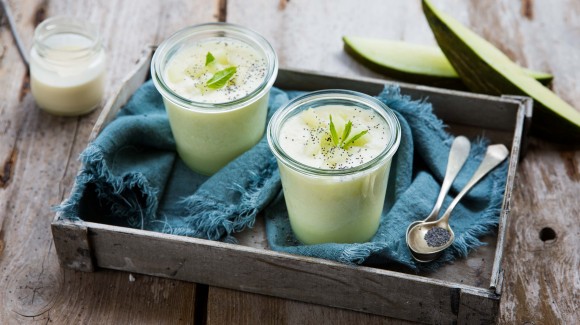Piel de Sapo is a melon we’re seeing more and more of in the supermarket – for good reasons. It’s got a similar flavour profile to honeydew but is a bit more subtle. Piel de sapo might be labelled as a Santa Claus melon or a croc melon, that looks like a papaya or pawpaw, and picking a good one can be tough. Look for the ugliest one you can find – with a golden circle where the melon rested on the ground and cracks on the skin, indicating a higher sugar content.
This dish is celebration food. It might seem simple on paper, but I guarantee if you follow the recipe, it will be an absolute delight.
It’s like a deconstructed pavlova with next to no effort, the ricotta whips up into a meringue-like cloud and the mint adds an aromatic background, underscoring the sweeter flavours with a fresh plumpness. It’s so simple, and so impressive.
The perfect dish for a champagne breakfast, a sweet summery brunch, or festive dessert. The ricotta can be prepared ahead, making this an easy entertainment option.
Preparation
- Slice the melon in half and remove the seeds. Cut into wedges, and then carefully remove the peel.
- In a small bowl, mix ricotta, ground cinnamon, icing sugar and vanilla extract until well combined.
- Spread the cinnamon-vanilla ricotta onto a serving platter. Arrange the melon wedges on top.
- Scatter blueberries over the melons and sprinkle with chopped pistachios.
- Garnish with fresh mint leaves for a burst of color and a refreshing flavor.
- Finally, drizzle a little honey over the top of the entire dish for extra sweetness.
Tips from the author
Get some tips on choosing the perfect piel de sapo on the links below:
What is a Piel de Sapo melon?

What is a Piel de Sapo melon?
The Piel de Sapo melon, although not widely known in Australia, is the melon of choice in Spain. Piel de Sapo means “frog skin” in Spanish, and while the rough mottled rind of these melons closely resembles the amphibian they are named after, it has led some Australian growers to call them "Croc-melons".
The melon is shaped like an oval, similar to a football. The thick rind means that Piel de Sapos possess excellent shelf life and transportability and its tough exterior hides a dense, juicy and refreshing sweet flesh that has to be tried to be believed.

How do they differ from a rockmelon or honeydew melon?
The Piel de Sapo is different in appearance both internally and externally to a rockmelon. They are green on the outside with creamy yellow flesh, similar to a honeydew but generally sweeter in taste.
When you cut a piel de sapo, don't cut too closely to the rind as that's where the melon isn't as sweet.
Where are they grown in Australia and when?
Piel de Sapos are available all year round as the melon can grow in southern Australia in summer and in northern Australia during the winter months.

How do I pick a good one?
The secret to picking a good Piel de Sapo melon is to select a firm, yellowing olive-coloured melon with ample ‘netting’ or ‘cracking’ lines on the skin. This indicates that the melon has been harvested at its peak so its pale green-coloured flesh is sweet and ready to eat.
Look for a yellow “dollar spot” at the stem and a yellow resting base. The melon will be non-aromatic.
How should I store the melon and how long will it last?
Once you cut this melon up to share it’s not likely to last long! But Piel de Sapos do have a long shelf life and are best stored at a consistent 7-8 degrees celcius. The melon doesn't like going in and out of refrigeration as the skin can condensate, resulting in black spots.
How should I serve a piel de sapo?
Although the Piel de Sapo is perfect on its own, its versatility allows it to be included in a range of meal occasions including for breakfast, as a snack, salads, appetisers, desserts and cheese platters paired with a crisp white wine. Click here for recipe ideas.
How to pick a ripe Piel de Sapo melon

Related salads chosen by others

Melon and lemon mousse
Average 3 of 5 stars
Pepper and walnut cake
Average 3 of 5 stars

